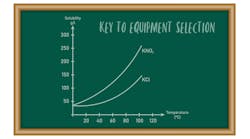Process engineering: Pneumatic conveying moves ahead
Pneumatic conveying has long been a popular choice for moving bulk materials, either from storage facilities to a process unit, or between process units. However, pneumatic conveying technology itself hasnt been standing still, and this can influence the choice between pneumatic and mechanical systems (such as conveyor belts or vibratory systems) and then among several types of pneumatic systems: dilute-phase, dense-phase or vacuum.
Generally speaking, mechanical systems make sense with short, straight runs within a plant; they require less horsepower and sometimes can be a less expensive capital cost, says Paul Solt, owner of Pneumatic Conveying Consulting, Allentown, Pa. But they are usually a higher-maintenance choice, have problems with dust generation or contamination of process material, and are not as flexible in dealing with plant-floor configurations. Given sufficient capital, there is nothing that cannot be pneumatically conveyed, he says.
Greg Steele, executive vice president for Dynamic Air, St. Paul, Minn., says, Over the past 15-20 years, weve received a tremendous boost from EPA and OSHA. One by one, industries or applications where mechanical conveying has been the traditional choice have gone to pneumatic conveying. A decade or so ago, it was dry laundry detergent, then it was rubber processing and more recently pharmaceuticals. With pneumatic conveying, you reduce emissions and cut down on plant housekeeping requirements.
Moreover, many new materials are more demanding to handle because of, for instance, reactivity or fire and health hazards; this also tips the scales toward pneumatic systems.
Because pneumatic systems run cleaner than mechanical ones and are less susceptible to product contamination, recycling materials is easier. A pneumatic systems generally smaller product holdup also is an advantage for recycling. Some conveying systems are designed to handle different ingredients of a batch at different times, or must move the complete content of each batch together (which makes recycling of residues problematic). Mike Salvador, operations manager at Nu-Con Equipment, Chanhassen, Minn., says modern pneumatic systems need to be engineered with precise tolerances and should be capable of being disassembled, inspected and cleaned easily.
Entering another phase
No strict physical distinction marks the two main design options for pneumatic conveying: dilute-phase and dense-phase operation (vacuum conveying, which will be discussed later, can operate in either regime). Dilute-phase conveying is simply lifting and blowing powders or particles down a line, usually at higher gas velocities. Dense-phase conveying involves calibrating the line pressure based on the physical characteristics of the process material, trying to achieve full fluidization of material in the line, but moving it at a lower velocity.
Dense-phase conveying was originally designed to meet the problems associated with the handling of abrasive materials, says Mike Weyandt, sales manager for Nol-Tec Systems Inc., Lino Lakes, Minn. With the higher velocities found in dilute-phase conveying, particles can essentially sandblast holes into the elbows or connections of pneumatic systems, or can be degraded by impact with the walls of the conveying lines. Many applications are now being handled with dense-phase systems because of process requirements that limit the amount of product degradation or separation allowable, he says.
With dense-phase conveying, the designer strives to load the line with as much process material as possible and to run it at the most energy-efficient condition, which is just below the rate that would cause plugging. Over long distances or with high loadings, pressure variations can cause plugging and, to counter this, equipment vendors have developed various types of boosters that inject additional air as needed.
Dynamic Air, which has been offering booster technology for several years, is now introducing the DC-5 Air Saver unit . Older boosters were simply put in place every 5 ft. or 10 ft. along a line and supplied a steady pressure, Steele says. Some designers also experimented with adding pressure sensors and process controls to the boosters. The DC-5 has a pressure-balancing valve that can regulate where pressure is applied automatically. In effect, the conveying line is constantly plugging and unplugging, which is the most efficient mode of operation.
Meanwhile, Nol-Tec recently introduced its Air-Mizer injector, which is also designed to operate automatically to control conveying velocity in the line.
The effectiveness of the dense-phase strategy is not guaranteed, cautions Don McGlinchey, director of the Centre for Industrial Bulk Solids Handling at Glasgow Caledonian University in Scotland. Much depends on the detail of the stressing mechanisms occurring during transport and the materials response. A dilute-phase system can be fairly forgiving to changes in material specification, but these tend to be more critical in dense-phase systems, leading to many operating problems.
Pulling a vacuum
Technically, the only difference between a pressurized system and a vacuum system is that the former pushes material through a line whereas the latter pulls it. However, the two systems pose distinct requirements for inlet feeding and outlet dispensing, and the physical properties of the material being conveyed or the process layout might make a difference.
A vacuum system tends to make the most sense when it is dispensing to a single destination, says Pneumatic Conveyings Solt. If there are several delivery points, the designer can split the flow of a pressurized system with diverter valves, which is not as feasible with a vacuum system, he adds.
Vacuum systems are limited in capacity by the difference between atmospheric and vacuum pressures, says Herman Purutyan, a vice president at Jenicke & Johanson, a materials-handling consulting company in Westford, Mass. With a pressurized system, you have the design flexibility to raise the pressure as high as you need.
Theres certainly no vacuum in terms of suppliers. For instance, IEDCO, Sewell, N.J., is now offering modular technology from Volkmann Vakuum Technik, Soest, Germany, to the North American market. IEDCO representatives say the technology is particularly suited to high-purity applications, such as pharmaceuticals or batch mixtures where there is concern about material left from a previous batch. A user can obtain dilute or dense-phase conveying by selecting from among 60 different vacuum generators; tangential or radial suction ports accommodate material properties such as dryness or stickiness, respectively, to control flow characteristics. Discharge valves have their pneumatic components outside the conveyor body, allowing for easy cleaning in place, according to IEDCO.
Cyclonaire Corp., York, Neb., addresses the pressure question both ways. Its HC Series system, thanks to a venturi tied to a blower, can use vacuum in one part and pressurized flow in another. A typical application would be vacuum unloading of, say, a railcar into a transfer vessel, according to the company. When the vessel fills, the system automatically cycles to a discharge mode, using the same blower to convey material along to its destination. Optional load cells allow the system to weigh and batch the process flow.
Because the pressurized side of the system uses relatively low air pressures, the system is well suited to handling abrasive materials. At cement-maker R-Cons Plant No. 6 in Wichita, Kan., the HC system unloads railcars carrying cement into the plant, where more than 200 concrete blends are produced in different colors or compositions to handle architectural requirements. The system addressed one pressing problem the buildup of dust in an unloading pit that had been caused by spillage from a screw-pump conveyor while raising capacity and productivity at the plant. Our railcars hold 80 to 84 tons each, and we unload them in about two hours, says Rick Heise, production manager. Theres no need to get down into the pit, no dust, nothing to clean up. When you time everything out, were getting the job done much faster.
Coming down the pipe
Most experts in pneumatic conveying agree that technology changes in the field have been evolutionary rather than revolutionary. Nol-Tecs Weyandt says the company has introduced new broken-bag detectors and rotary feeders, which help streamline operation at the feed end of a conveying system. Pelletron, Lancaster, Pa., now offers several types of engineered elbows to improve the abrasion resistance of a conveying line. Nu-Con has launched a compact rotary-valve tube selector that allows a conveying system to feed multiple lines or to converge multiple lines into one; the unit has inflatable seals on all ports to ensure airtight conveying.
System design might be poised for potentially significant changes, thanks to the emerging commercial use of a new software combination: the tying together of computational fluid dynamics (CFD) with so-called discrete element modeling (DEM).
CFD, which has been used in commercial applications in the chemical industry for more than a decade, models continuous fluid phases such as air flowing around a shape. Our multiphase models have been used to solve particulate flow problems where the focus has been the effect of fluid mechanics, as opposed to particle dynamics, says Ahmad Khadari, a business manager at Fluent Inc., Lebanon, N.H.
Classical applications of this technology include cyclone separators, fluidized beds or classifiers.
However, to analyze a system from the perspective of the particles a discontinuous phase another approach is needed, hence DEM. It originated, says John Favier, president of DEM Solutions, Edinburgh, Scotland, in geomechanics, where it was used to analyze a problem like the load of a building atop a gravel bed. Weve been constrained by the availability of computational power, he says. In the past, we were able to analyze thousands of particles in one system at a time; currently we can process hundreds of thousands, and very soon we will be doing millions.
At that level of detail, modeling the interparticle effects of something like a dense-phase flow or a complex geometry within a conveying-system component becomes feasible. This can eliminate previously necessary simplifications and potentially provide more accurate results.
DEM Solutions is advancing with several efforts to have DEM address materials-handling problems in the commercial arena. Favier says the company has a project with John Deere, Moline, Ill., to analyze the flow of grain particles in its harvesting equipment. It also formed an alliance this fall with Fluent to combine its program, called EDEM , with Fluents CFD software.
Industry experts are taking a wait-and-see attitude. DEM, or CFD for that matter, arent really there yet, says Jenicke & Johansons Purutyan. A pneumatic conveying system can be very complex to model and, so far, all the simplifying assumptions you have to make limit the softwares predictability. Instead, he recommends trying the actual process material in a test system and using the results for design.
Ted Knowlton, director of the Particulate Solids Research Institute (PSRI), Chicago, an industry-funded consortium to conduct research in materials handling, says the institute is evaluating several CFD packages and expects to have at least one in use within the coming year.
PSRI provides regular input about what is going on in CPs PowderHandling Insider e-newsletter.


